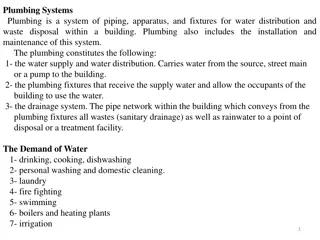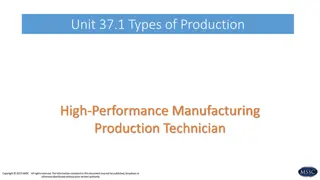Understanding the Importance of Jigs and Fixtures in Production Techniques
Jigs, fixtures, and specialized tooling equipment play a crucial role in reducing production costs while maintaining accuracy and interchangeability of parts. They are essential in job production, batch production, flow production, and mass production. By ensuring accuracy, interchangeability, and economic production rates, jigs, fixtures, and tooling equipment help meet the quality and quantity requirements of modern engineering production. Learn about the definitions, functions, and specifications of jigs and fixtures in manufacturing processes.
Download Presentation

Please find below an Image/Link to download the presentation.
The content on the website is provided AS IS for your information and personal use only. It may not be sold, licensed, or shared on other websites without obtaining consent from the author. Download presentation by click this link. If you encounter any issues during the download, it is possible that the publisher has removed the file from their server.
E N D
Presentation Transcript
JIGS AND FIXTURES By improving the production techniques and providing specialized tooling equipments, such as jigs, fixtures, special tools, and gauges,the production cost have reduced considerably without sacrificing the accuracy and interchangeability of parts and components. To achieve the desired quality and quantity of production, the concept of accuracy and interchangeability go hand in hand. They play a major role in meeting the present day classes of engineering production, namely, flow production and batch production . 1
To necessitate the need of jigs, fixtures and special tools, the four main engineering classes of production are as follows: 1. Job Production: This involves the manufacture of specialized components or systems to meet the specific needs of the customers. Examples of job production are the manufacture of jigs, fixtures and press tools. 2. Batch Production: Some of the examples of batch production are the manufacture of aeroplanes, aero-engines, battle tanks, etc., that use the concept of intermittent manufacture of large products, produced in batches. 3. Flow Production: In flow production, the standardised finished products are produced in plants, specifically laid out for this purpose. Examples of flow production are the modern motorcar plants. 4. Mass Production: In this type of plants, the products are produced in mass quantities by specialized and repetitive methods, without requiring specialized layouts as in the case of flow production. Examples are mass production of screws, pins, hand tools, like chisels, spanners, hammers, etc. 2
DEFINITION OF JIGS, FIXTURES AND TOOLING Components and Systems are produced to meet the basic specifications of: (i) Accuracy (ii) Interchangeability (iii) Economic production rate. In order to achieve the above objectives the following tooling equipments are deployed: (i) Jigs (ii) Fixtures (iii) Special tools (e.g. broaching tool, gear shaping tools, special taps and reamers) (iv) Gauges to verify if dimensions are within the limits. 3
A jig is a device, in which the component is clamped in a specific location so that cutting tools are guided to perform one or more operations. Jigs, which are independent devices, are fastened to the table of a machine tool. They are so designed to facilitate loading and unloading of components with ease. The third feature of a jig is that it has locating devices to position a component in a unique way. The fourth aspect of a jig specification is the gripping of the work piece through a clamping device. 4
There are elaborate methods to clamp, namely, (a)threaded fasteners,(b)cam clamps, (c) V type sliding clamps, (d)pneumatic clamps, (e) hydraulic clamps, etc. The fifth aspect of the specification of a jig, which distinguishes the same from a fixture, is the guiding bushes which are fixed/fastened to the jig body or frame and act as guides to the tools, especially drilling, reaming or face milling cutters. They enable the tool to be positioned exactly with respect to the component and more precisely in relation to the location of the hole to be drilled, or the hole to be reamed. 5
A fixture is a device, which is fastened to the table of a machine tool, such as milling machine, and in the case of turning operation in a lathe, the fixture is fastened to the chuck or a faceplate. The device also enables loading and unloading of components with ease. The third aspect of unique location of workpiece in relation to the fixture also holds good as in the case of a jig. The fourth aspect is that the clamping force should be able to withstand the cutting force. At the same time, the clamping force should not be excessive, as it may cause damage to the part. 6
The final aspect, which distinguishes a fixture from a jig, is the absence of bushes to guide the tools. In lieu of the guiding bush, the fixture deploys setting blocks to locate the cutter properly in relation to the fixture or the components per se. However, the requirement of setting blocks may not be always necessary as in the case of turning or welding fixtures. 7
FUNDAMENTAL CONCEPTS IN THE DESIGN OF JIGS AND FIXTURES The basic difference between the design of Jigs and Fixtures and that of machine tool components is that, the designing of jigs and fixtures calls for extreme accuracy followed by rigidity, whereas in the case of various machine elements, the concept of stress analysis plays a vital role. Therefore, the design of such special devices calls for in-depth knowledge on material specifications, mechanics of metal cutting, concepts of accuracy, simplicity, strength, safety and economy. 8
The designer of these special tools should be capable of preparing manufacturing drawings to meet the specific requirements of each job, its production scheme, rate of production, and the level of dynamic forces involved. As indicated earlier, the design of jig has the following aspects or elements: (i) Unique location of components with respect to the jig. (ii) Ease of loading and unloading the components (iii) Clamping of the components so as to impart adequate clamping force and also to have ease in operation. 9
(iv) Guiding the cutting tools (v) Provision for swarf removal (vi) Proper fastening methods to hold the jig to the table (in the case of radial drilling machines) (vii) Holding the assembly together so as to withstand the cutting forces which occur at frequent intervals causing static and dynamic forces (viii) Provision for replacement of bushes, in case different tools like reaming subsequent to drilling are used for drilling different diameter holes in the same location. 10
Following are the major elements in the design of fixtures: (i) Unique location of components with respect to the fixture (ii) Clamping techniques to be adopted to deploy adequate forces without damaging the component; ingenuous techniques to be adopted for the ease of clamping like quick acting screws, cam clamps, hydraulic clamps, etc. (iii) Provision for easy loading and unloading of components (iv) To hold the assembly together to withstand the cutting forces 11
(v) To design the location, size and material of the setting block to enable the cutter to be set in relation to the fixture and to be precise in relation to the component to be machined this is applicable only for milling fixtures (vi) Provision for swarf removal (vii) Fastening of fixture to the machine table or chuck or collet (viii) Proper design of tenons at the bottom of the fixture so as to properly locate the fixture with respect to the machine table. 12
In addition to the said points, the following aspects should also be taken into account in the design of jigs and fixture: (i) Consideration of sequence of operation given in the operation chart with particular reference to the operation to be performed (ii) Study of the detailed drawing of the component critically, especially the dimensions which are provided with tolerances (iii) Consideration of the manufacturing defects such as (a) shrinkages (b) blow holes, (c) inclusions as in the cast bodies of jigs, (d) distortions as in the case of welding and fabricating jig body or frame. 13
Location and clamping As mention earlier two most important features or aspects to be considered in design of jigs and fixtures is to provide means for locating and clamping in workpiece. Locating is done to constrain or to reduce the degree of freedom of the workpiece so that is at its exact location in machining operation. Various types locators are cylindrical locators, Long locators, V locators, both fixed and sliding, Conical locators, Diamond pin Locators, Profile locating pins, Nested locators and Eccentric locators. 14
A tool designer defines clamping as, the holding of workpiece against the cutting forces; while the workpiece presses against the locating surfaces. Important aspects to be provided in clamping are: (a) the workpiece must be held firmly even when the tools/cutters are in operation; (b) the clamping device should be quick acting as the loading and unloading time should be short; (c) when subjected to excessive vibration, the clamps should be firm and should not loosen up; (d) the clamp should not damage the workpiece. 15
Types of clamps with respect to actuating power are: mechanical clamps, hydraulic clamps, pneumatic clamps and electromechanical clamps. To design or to select a clamping device, the general guidelines to be followed are: Simple clamping mechanisms should be adopted, to save the cost of manufacturing and ease of maintenance. Clamping parts, which are subjected to wear and tear, should be heat-treated. The material of the clamps should be so selected as to have properties like hardness, toughness and strength. 16
Wearable parts of the clamps should be so designed as to be easily replaceable. Clamping force should be applied to a heavy part of the workpiece. Thrust of the cutting tool should be away from the clamp. Pressure pads should be employed wherever soft objects or hollow objects are to be clamped to avoid damage or distortion. 17
Clamps in common use are: Clamps with heel pin, Spherical washer, Two/three point clamps, Latch type clamps, Button clamps, Pressure pad, Wedge type clamp, C-washers, Swing washer, Equalising clamp, Swinging bolt and removable clamps, Clamp for two components, Cam clamps, V- clamps, Toggle clamps, Quick acting nut, Pneumatic clamps and Electromechanical clamps 18
Thank you Thank you for your for your attention attention 19























